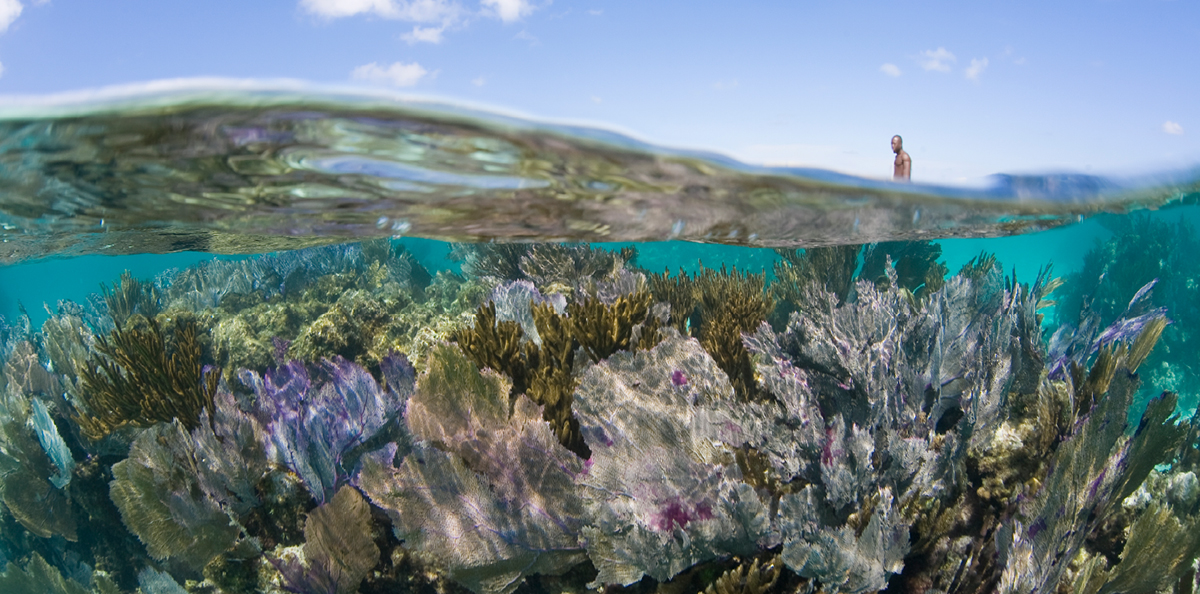
The Nature Conservancy has grown to become one of the most effective and wide-reaching environmental organisations in the world. All images copyright: Carla Sanatana/ TNC Photo Contest 2019, Ethan Daniels, Randy Olsen, TNC Belize, Claire Ryser/TNC Contest 2019, Julieanne Robinson Stockbridge
Non profit environmental organisation, The Nature Conservancy, has over 400 scientists working and impacts conservation in over 75 countries and territories. With the UN Ocean Conference currently taking place in Lisbon, Melissa Garvey, Global Director, Ocean Protection at The Nature Conservancy speaks to LUX about the effectiveness of philanthropy and investment to protect the oceans
LUX: The Nature Conservancy has an interesting niche, combining philanthropy and investment. How does that work?
Melissa Garvey: The Nature Conservancy is a global environmental nonprofit working to create a world where people and nature can thrive. Building on nearly six decades of experience, we’ve protected more than 280 million acres of ocean, 119 million acres of land, and 5,000 river miles. We are able to accomplish so much because we make careful use of our resources, maximising the philanthropic and public funding that goes toward our science-driven program work.
We are also able to leverage philanthropic funding with innovative finance strategies. The Nature Conservancy has an impact investing unit that works with our conservation colleagues and collaborators around the world to source and structure investment products that support TNC’s mission at scale. With partners, we have been able to originate, structure, fund and close investment vehicles representing more than $2.3 billion of committed capital. Philanthropy is instrumental in supporting our teams to develop, execute and manage innovative finance strategies that allowing TNC to help countries access billions of dollars in long-term funding for conservation.

LUX: Financing is a key barrier hindering ocean protection. How are you overcoming this barrier?
MG: The Nature Conservancy’s Blue Bonds Strategy is one solution. We transform debt into conservation action at scale.
At the heart of these projects is a basic deal: A coastal nation commits to protect approximately 30% of its near-shore ocean areas. In support, TNC refinances the nation’s sovereign debt, leading to lower interest rates and longer repayment periods. The government uses the savings to capitalise a conservation trust fund to support new marine protected areas to which the country has committed.
TNC’s role is to assemble the deals, use our science and a stakeholder driven marine spatial planning process to facilitate the design of a system of protected areas and create a trust fund that holds the government accountable to its commitments—ensuring that we finance real conservation, not paper parks.
Follow LUX on Instagram: luxthemagazine
An example of this is the $553 million debt refinancing we completed in Belize in November 2021. This project enabled the Government of Belize to reduce its debt burden and generate an estimated US$180M for marine conservation in support of Belize’s commitment to protect 30% of its ocean, strengthen governance frameworks for domestic and high sea fisheries, and establish a regulatory framework for coastal blue carbon projects. This is especially meaningful to the people of Belize as the country’s tourist-based economy continues to suffer from the impacts of COVID-19
Our goals is to project 4 million square kilometres of ocean and unlock $1.6 billion for marine conservation.

LUX: Are blue bonds going to become more significant elements in the market?
MG: The TNC Blue Bonds debt conversion structure is highly scalable and replicable. Transaction sizes and overall market are limited by three criteria:
1)Countries committed to achieving the conservation outcomes. As the threat of climate change and awareness of the role that natural resources and biodiversity play in economic growth rapidly increase, most developing countries will require additional financing for conservation.
2)Availability and affordability of credit enhancement, whether through the US Development Finance Corporation or development banks to do more deals in more markets.
3)Availability of debt to refinance: while debt conversions work well with sovereign debt trading at a discount in the capital markets, they are not exclusively for countries threatened by high debt distress. Many countries have high-coupon bonds. Even if these trade at little to no discount, they can still be refinanced with lower coupons and longer tenors to create significant funding for conservation. Many also have commercial bank loans that may be candidates for refinancing into a lower interest rate and/or longer tenor loans.

LUX: How will sustainable blue economy finance need to develop over the next few years?
MG: Sustainable blue finance is essential to national economies and the 3 billion people rely on healthy oceans for their livelihoods. Financing often holds back countries from implementing ocean conservation that will ensure oceans are sustainable into the future. Philanthropic and public funding is essential but insufficient to close this gap.
Today the challenge of financing the sustainability of our oceans is compounded by the Covid 19 health pandemic and the financial crisis, which has placed unrelenting pressure on public finances and slashed tourism revenues. But there is hope. Innovative debt and market approaches can help bring in new funding at a scale that can address the problem.
LUX: Are you looking for UHNWI individual investors, institutional investors or philanthropists?
MG: Philanthropy is instrumental in supporting our teams to develop, execute and manage strategies, policy and partnerships – including innovative finance strategies — that allow TNC to help countries access billions of dollars in long-term funding for conservation. We simply couldn’t do our work without the generosity of individual and institutional supporters.

LUX: Do governments need to become much more active on ocean protection?
MG: Governments are already active in ocean protection, and there is a lot more to do. We are already three years into the decade during which we have to bend the curve on biodiversity loss. So, this year the global community must finally agree a new and ambitions Global Biodiversity Framework, including a target to globally protect 30% of freshwater, land and the ocean. To deliver against this target, countries must also conclude negotiations in 2022 on a new treaty for the protection and sustainable use of the High Seas with clear powers to establish protected areas in areas beyond national jurisdiction. But we can’t wait for these treaties to be negotiated before we act. The UN Ocean Conference is an opportunity for the ocean community to both demand action and offer solutions.
LUX: Is there is a risk of creating an uneven market with low-regulation governments allowing exploitative practices on a large scale?
MG: There are always a risk like this. But investing in the health of oceans creates long term benefit. Globally, the gross value of marine ecosystem services is estimated at US $49.7 trillion. This suggests that the economic benefits would far outweigh the costs of establishing a 30% global MPA network. We are developing a costing framework to help decision makers in individual countries better understand today’s costs of implementation and management of ocean protection as well as the long term benefits of marine conservation so that governments, NGOs and the private sector can make more informed choices.
LUX: How important will the role of science and innovation be in the Blue Economy? Can you give some examples?
MG: Science and innovation are essential for Blue Economy interventions that change the way that we protect and value oceans. For example, did you know that you can insure the protective value of nature? You can.

It works like this: We know that reefs can decrease the power of waves coming on shore by about 97%. That is really important during the ever more frequent – and increasing more severe – storms. But these storms also take a toll on reefs, which leave coastal areas at greater risk to future damage if the reef isn’t restored. We worked with the insurance industry and put that science into insurance models. Together, we came up with the world’s first insurance policy to insure a portion of the Meso-American reef in Quintana Roo, Mexico that protects areas near Cancun and its $10B tourism industry from hurricanes. If a storm hits, the insurance is triggered to ensure that the reef can be quickly restored. This insurance was tested in the Autumn of 2020 when Hurricane Delta hit. The $800,000 insurance payout funded vital reef repair activities. This is a win for nature, a win for coastal communities and will drive further interest in conservation finance and the need to protect marine ecosystems across the globe.
Read more: Julie Packard: All In Together
LUX: There is no metric to compare the value of different nature-based solutions in ocean conservation, and no consistent measure of the effectiveness. Is this true, and is it an issue?
MG: I don’t agree that we can’t measure nature-based solutions. The reef insurance I mentioned above is one example. Here’s another: Blue Carbon Resilience Credits. We know that the coastal wetlands provides a unique opportunity for climate finance. If we restored even a quarter of these habitats, we would add 10 million hectares of carbon-trapping wetlands to our coastlines. That is an area equivalent in size to Iceland. In addition, protecting existing coastal wetlands would prevent the release of 80 million tons of carbon emissions currently being stored by these habitats.

TNC worked with international experts to develop science, flood modelling, and carbon and resilience methodologies for the Blue Carbon Resilience Credit. These credits support not just carbon mitigation, but also quantifiable, verifiable resilience benefits like flood reduction to adjacent communities. We have identified projects across the US and globally and are bringing our first supply of Blue Carbon Resilience Credits to market.
LUX: You say a comprehensive approach is best for ocean investment. How should this work?
MG: To achieve truly durable ocean protection, we have to focus on scale and representativeness of the areas we conserve, as well as ensuring long term financing for conservation, and equity and sustainable livelihoods for the people who rely on oceans. Our global ocean protection program drives new protection, restoration, and management improvement in support of biodiversity and communities.
We work at multiple scales. We address the long-term need to secure large-scale new protection and sustainable financing for marine conservation while we tackle today’s urgent need to restore critical coastal ecosystems — like coral reefs and coastal wetlands — and improve management of our oceans, while we build capacity for communities to manage their marine resources.
Find out more: nature.org







